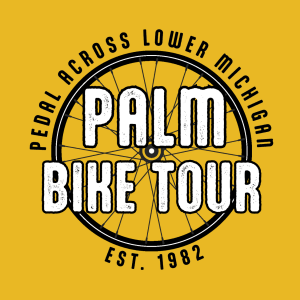See page 6 from the Participant Packet on our Downloads page.
► Is your body ready for a six-day tour?
For those of you who have never participated in a multi-day ride, you may be asking yourself: how do I get physically ready?
PALM is geared toward families and beginners and the daily mileages reflect that. However, how easy the ride will be for you, and especially how much you enjoy yourself, is directly proportional to how well you prepare.
Start riding in the spring as soon as the weather permits.
Try to ride at least 3 times a week. In the beginning, try for at least 5-10 miles. After 2 weeks, add an additional 5-10 miles to each ride. After a few more weeks, add another 5-10 miles per ride. Continue this gradual building up until you get to at least one 50-mile ride each week right up to PALM.
The secret is to not only build up your muscles and aerobic capacity, but to become comfortable in the riding position and especially the saddle. Everyone, even pro riders, get a sore posterior. Take a “butt break” every 10-15 minutes while riding by coasting, standing up on the pedals, and stretch; first one leg, then the other.
Get off the bike for at least few minutes every 10-20 miles. You have all day to get to the next site and there’s plenty to see and do along the way.
Remember, PALM is not a race. Enjoy the scenery!
► Is your bike ready for a six-day tour?
For a bike ridden only on pavement, if it has been more than 5 years or 2000 miles, you may need an overhaul. All the bearings will need to be cleaned and repacked with grease. That includes the front and rear hubs, bottom bracket, headset, and pedals. You may also need a new chain, cables or brake pads.
If you are not comfortable servicing your own bike, take it to your local bicycle shop to have it tuned up and checked out. Make sure to tell your mechanic that you are going on a tour. A good mechanic will find anything that is likely to go wrong during the tour.
While you’re there, ask them to see if the bike is properly set up for you. Have them look at the seat’s height, tilt, and fore-aft position, as well as the handlebar position, to be sure everything is set up properly for you. Remember that these are starting positions — as you ride, you may want to make adjustments. Ask the shop how to make these adjustments so that you can do them yourself.
What’s in your on-bike tool kit?
The most likely mechanical problem you might have is a flat tire. At a minimum, you should carry a spare tube, tire levers, a patch kit and a pump or CO2 kit.
Someone in your group should also have a chain tool and a spoke wrench. You don’t want a broken chain or a warped wheel to cause you to miss a day’s ride.
Also, carry all the tools necessary to tighten all the nuts, bolts, and screws on your bike. Some tool kits are pretty complete and include the seat bag. Multi-tools can replace many individual tools. Make sure you know how to use the tools you carry.
Remove your bicycle from the roadway completely before starting to work on your bike.
